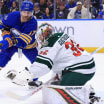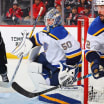Daily fantasy hockey gives fans a chance to compete with friends or other players around the globe within the scope of a single-day slate of NHL games.
DraftKings offers daily contests almost every night of the NHL regular season. This primer will give you an overview of how to play DFS hockey and give you tips and strategies for opening night and throughout the season.
Daily fantasy hockey strategy guide
NHL.com provides DFS primer with important information, advice

© Codie McLachlan/Getty Images
By
Ben Zweiman @BZweimanNHL / NHL.com Staff Writer
BASICS
For those of you who aren't familiar with daily fantasy sports, it gives you the opportunity to draft any players you desire on any given night based on the DraftKings salary landscape. Each player is given a price figure that changes throughout the season based on matchups and performance. You're provided with a $50,000 DraftKings salary cap budget to fill out a roster of two centers, three wings, two defensemen, one goaltender and one utility spot (for an extra forward or defenseman).
SCORING
DraftKings scoring is pretty simple, and contest rules can be found
here
. As you can see, goals, assists and wins are the three primary stat categories in DFS NHL contests. Because of this, most high-scoring forwards and stud goaltenders are among the highest-priced players on a nightly basis. But don't forget that the secondary stat categories are what separates the above-average plays from the elite ones.
Shots on goal and blocks are each worth 0.5 points and are paramount in increasing a players daily fantasy floor. These categories balance the scoring difference between forwards and defensemen, considering defensemen usually have a much higher blocks-per-game average.
A good example of how this affects forwards is the difference between Toronto Maple Leafs center Auston Matthews ($7,900 at WPG) and Winnipeg Jets center Mark Scheifele ($6,600 vs. TOR). At first glance, you can tell Scheifele is $1,300 cheaper than Matthews. You may also remember that Scheifele finished seventh in the NHL in scoring last season (82 points in 79 games) with 13 more points than Matthews (69). The difference, though, is Matthews scored eight more goals and was eighth in the NHL with 279 SOG in 82 games. Because of Matthews' shot volume and higher odds of scoring a goal, he's priced that much higher than Scheifele.
We'll use two Philadelphia Flyers defensemen as examples in our next study. Shayne Gostisbehere ($4,600) comes in slightly above teammate Ivan Provorov ($4,500). We know Gostisbehere will get more power-play time and is more of a threat to score, giving him a higher ceiling (or expected DFS output) than Provorov. But where Provorov lacks in scoring prowess, he makes up for with secondary coverage. Provorov was tied for ninth in the NHL with 166 blocks (2.0 per game) last season. Coupled with his 2.0 SOG per game average, Provorov is almost guaranteed to score 2.0 DraftKings points. If Gostisbehere doesn't score a point, he could come up empty, while Provorov's floor is high enough to be employed without being dependent on scoring.
CONTESTS
DraftKings features two types of NHL contests to choose from: tournaments and 50/50s.
Let's start with tournaments, since these will be the most popular and frequently played by most beginners. Tournaments usually have bigger prize pools but you'll also be competing against upwards of 50,000 fantasy owners. The entry fee is usually low for big GPPs (guaranteed prize pools), but the chances of you placing in the money range are also low. You're allowed to risk more to join smaller tournament formats, but again, these will cost a fair amount and aren't recommended for beginners. There are also tournaments that only allow you to enter one lineup (single entry) and others that allow you to submit as many lineups as you want (paying the entry fee for each one).
On the flip side, 50/50 contests and double-ups scale depending on how much the entry is. If you're entering a lineup for $1 and the prize pool is $20, the top 10 scores will double their money to $2. Most of this is covered when entering contests on DraftKings. Also in the 50/50 category are multiplier contests, which allow you to win up to 5x more than your entry fee, but less than 50 percent of owners place in the money range.
Aside from those two main contest types, there are contests for beginner and casual players, as well as satellite contests and qualifiers, where you can win tickets to bigger tournaments and world championships. There are also head-to-head formats, where you can square-off against another owner, one on one.
STRATEGIES
Differentiate yourself from the pack in tournaments
When you're going up against thousands of other lineups, you need to assume that the most obvious players are going to be heavily owned. For example, the ownership percentage of Edmonton Oilers center Connor McDavid ($8,300 vs. CGY) will likely be highest of any player on opening night. If a player is priced particularly low for their expected output, like McDavid's teammate Leon Draisaitl ($6,000), it's fair to expect him to also have high ownership.
This doesn't mean you should fade the top players in every tournament; it just means you should pick your spots. If you think McDavid has a great chance to score at least two points against the Calgary Flames on opening night Wednesday, then spend up for him in your contest. But just know that it's tough to get by on a bunch of chalk plays in tournaments. You'll want to find some contrarian appeal in certain players, guys who aren't going to be heavily owned but have upside and a higher ceiling than usual. Whether your reasoning is based on an injury, matchup, recent production trend or gut feeling, you'll want to scatter a few across your lineup.
On opening night, many lineups will target players from the Oilers, Flames, Maple Leafs and Jets. Not as many will feature players from the Flyers and St. Louis Blues. Top-six forwards Wayne Simmonds ($5,900) and Jakub Voracek ($5,900) are solid contrarian plays against the San Jose Sharks given their expected usage and projected low ownership.
For the Blues, forwards Jaden Schwartz ($5,600) and Brayden Schenn ($5,400) are each viable. Schwartz is expected to start on the top line with Vladimir Tarasenko ($7,400), and Schenn is a threat on the power play (T-NHL lead with 17 PPG last season).
Stacking lines
The idea of drafting multiple players from a particularly line or lineup who have a favorable matchup is a popular practice in DFS NHL. In hockey, if one player on a line is producing, chances are the other two players on that line could see the splash effect. And because teams don't generally place all their best players on one line, this can create bargain options from the top offenses in the League.
The Maple Leafs lineup is filled with appealing stacks, starting at the top with Matthews, William Nylander ($5,800) and Zach Hyman ($5,300). As you can see, Nylander and Hyman are each extremely cheap compared to Matthews, but could return more value. The more the line produces, the more your score will increase.
If you're worried about the risk involved in stacking one line, you can also draft two players from a particular power-play unit. The Oilers like to spread out the offense with the man-advantage and could feature McDavid with cheap forward Mark Letestu ($3,800) and defenseman Oscar Klefbom ($4,900). Letestu doesn't need to do much to return value, and Klefbom will also be heavily exposed to McDavid and Draisaitl at even strength.
Know when to pay for goaltending
There are a few key factors when considering which goaltender to use on a nightly basis. The most obvious is win chasing; which goalie has the highest probability of getting a win regardless of price? For the most part, if a goalie has a good chance to get a win, then they have a good shot at returning value. A few statistics to keep an eye on include save percentage of the goalie and the Shot Attempts percentage of the team. If a goaltender's SV% is high (in the .915-.930 range) and his team is dominating the shot attempts (and thus time of possession), then that goalie should be able to maximize saves and limit the amount of goals allowed.
The problem with using that strategy is that most goalies who follow that trend will be expensive. There are only so many points a goaltender can produce in DFS. For example, a goalie who makes 30 saves (6.0 points), gets the win (3.0 points) and a shutout (2.0 points), only puts up 11.0 fantasy points. The goaltender ceiling is extremely low and their floor is dependent on a high volume of shots, which increases the amount of goals allowed. A forward or defenseman who scores two goals, an assist and six shots on goal, also puts up 11.0 points, a much more likely stat line for elite players.
Paying less for a goalie is a logical strategy in cash games because you're able to save salary. You'll then be able to pay up for better forwards and defensemen, who take up a bigger chunk of your roster and have higher ceilings.

















